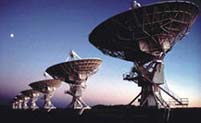Astronomers have top star list for extraterrestrial life
Astronomers looking for extraterrestrial life now have a short list of places to point their telescopes.

They include nearby stars of the right size, age and composition to have Earth-like planets circling them, scientists said.
But cuts in federal funding mean that private philanthropists who pay for the bulk of their work may find out first when and if extraterrestrial life is discovered, the astronomers told a meeting of the American Association for the Advancement of Science.
Margaret Turnbull of the Carnegie Institution of Washington released her "top 10" list of potential stars to the meeting. They will be the first targets of NASA's Terrestrial Planet Finder, a system of two orbiting observatories scheduled for launch in 2014 and 2020.
"There are 400 billion stars in the galaxy, and obviously we're not going to point the Terrestrial Planet Finder ... at every one of them," said Turnbull, reports CNN.
According to New Scientist Space, a stronomers searching for advanced life beyond Earth should focus their attention around beta CVn, a binary star roughly 26 light years away that resembles our Sun.
The recommendation comes from a shortlist of likely life-bearing systems compiled by Margaret Turnbull, at the Carnegie Institution of Washington, and presented at the annual meeting of the American Association for the Advancement of Science in St Louis, Missouri, US.
She adds that researchers looking for any kind of life – including basic forms that could not send communications to Earth – should take a particularly close look around another star, epsilon Indi A.
Both of the stars share similar traits, Turnbull says: "They're mature, very stable, calm stars. They're stars that are acting like they're taking care of someone."
O.Ch.
Subscribe to Pravda.Ru Telegram channel, Facebook, RSS!





